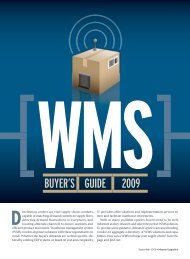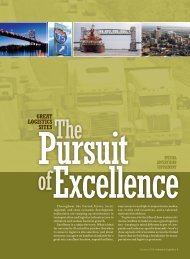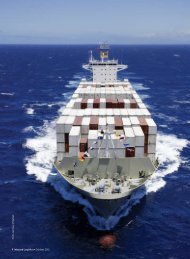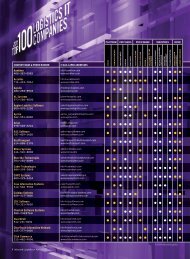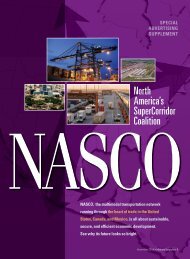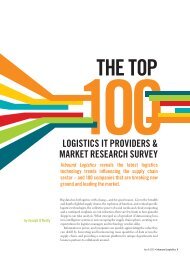Inbound Logistics | Utilities and Site Selection: Energized for ...
Inbound Logistics | Utilities and Site Selection: Energized for ...
Inbound Logistics | Utilities and Site Selection: Energized for ...
- No tags were found...
Create successful ePaper yourself
Turn your PDF publications into a flip-book with our unique Google optimized e-Paper software.
Sponsored Editorial<strong>Utilities</strong> & <strong>Site</strong> <strong>Selection</strong><strong>for</strong> SuccessThe availability of low-cost<strong>and</strong> reliable energy createssuper-charged opportunities<strong>for</strong> locating warehouses<strong>and</strong> distribution centers.August 2012 • <strong>Inbound</strong> <strong>Logistics</strong> 1
<strong>for</strong> SuccessImagine building your dreamhome, only to discover whenthe power bill arrives that youcan’t af<strong>for</strong>d the energy to heat,cool, <strong>and</strong> light the house.For many businesses selectingsites <strong>for</strong> new distributioncenters <strong>and</strong> warehouses, ensuringadequate <strong>and</strong> af<strong>for</strong>dable energy topower the facility presents a challenge.Smart companies enlist local resources tohelp explore utility costs in municipalitiesthey are considering <strong>for</strong> new locations.Ensuring the availability of reliable <strong>and</strong>low-cost power is an essential site selectionconsideration, so it is not surprising thatthe geographical regions positioned to offerthe best utility deals are aggressively sellingtheir advantages to manufacturers <strong>and</strong>third-party logistics providers seeking thepower of, well, power.Kentucky Comes CleanWhen it comes to the price of power,Kentucky is one of the most economicalstates in the country. “<strong>Utilities</strong> in Kentuckycost 25 percent less than the nationalaverage,” notes Erik Dunnigan, commissionerof the Department <strong>for</strong> BusinessDevelopment <strong>for</strong> the Commonwealth ofKentucky. The department recruits companiesto the area, <strong>and</strong> encourages jobretention <strong>and</strong> creation by working withexisting businesses <strong>and</strong> industry to enhancethe overall viability of the state’s economy.Prominent among the factors contributingto Kentucky’s competitive edge are thebenefits of clean coal technologies. Coalfiredpower plants produce more than 90percent of Kentucky’s electric power, withthe balance generated by hydroelectricdams, fuel oil, <strong>and</strong> natural gas. Kentucky’slarge reserves of unmined coal ensureabundant supplies of electric power <strong>for</strong> the<strong>for</strong>eseeable future.These benefits serve the companies thatmake up Kentucky’s diverse manufacturingbase. “The state is home to the automotive,food, pharmaceuticals, <strong>and</strong> plastics industries,”Dunnigan says.Over in Missouri <strong>and</strong> Illinois, AmerenCorporation works to promote energyefficiency <strong>for</strong> its 2.4 million electric <strong>and</strong>900,000 natural gas customers through avariety of green initiatives offering incentivesto help reduce costs.“Ameren’s commercial rates fallbelow the national average,” says CherylWelge, business development executivein Ameren’s economic developmentdepartment. Her claim is validated by anEdison Electric Institute study showingthat Ameren Illinois commercial customerspay 18 percent less than the nationalaverage, while Ameren Missouri commercialcustomers pay 33 percent less than thenational average.Commercial energy users can saveeven more by taking advantage of energyefficiencyincentives, particularly inrefrigerated facilities. Illinois’ deregulatedenvironment provides commercial customersyet another incentive to locate there.One common thread runs through theregions where utilities are at their mostefficient <strong>and</strong> economical: the partnerships<strong>for</strong>med between government <strong>and</strong>the utilities. It helps, of course, if you happento control the utility itself. That’s thecase in Nebraska, where the state’s citizensown the Nebraska Public Power District(NPPD), the state’s largest electric utility.“Nebraska’s status as the only publicpower state in the country provides a significantadvantage to businesses that chooseto locate here,” says Rick Nelsen, NPPDeconomic development manager. “Itmeans the primary goal of Nebraska’s electricutilities is to provide low-cost power,rather than shareholder profits.“Public power also means Nebraska’sutilities are financed, in part, through issuing<strong>and</strong> selling tax-exempt revenue bonds,resulting in lower interest rates on borrowedmoney,” he adds. “Maintaining apublicly elected board as our decision- <strong>and</strong>During site selection <strong>for</strong> warehousing <strong>and</strong> distribution facilities, companies must ensurelocal utilities generate sufficient power to run their buildings efficiently.2 <strong>Inbound</strong> <strong>Logistics</strong> • August 2012
Least Cost Connections to Midwest MarketsSelected business costsfrom 18% to 27% belowthe national average costs<strong>for</strong> Distribution Centers.Take advantage of:• A regional customer base of nearly 78 million.• Unsurpassed infrastructure: Class 1 rail, intermodal, air, interstates<strong>and</strong> river.• A location positioned to benefit from shifts in internationaltransportation lanes.• Tremendous community resources, transportation assets <strong>and</strong>work<strong>for</strong>ce availability.Ameren’s Economic Development Team is ready to helpwith your site search.www.ameren.com/EcDev eddept@ameren.com800-981-9409ED <strong>Inbound</strong> <strong>Logistics</strong> Ad.indd 18/6/10 2:06 PM
<strong>for</strong> Successrate-making body allowsNPPD to move morequickly than other utilitieson key issues.”NPPD’s chartered territoryincludes all or parts of91 of Nebraska’s 93 counties.The utility’s revenuesare derived mainly fromwholesale power supplyagreements with 52 towns<strong>and</strong> 25 rural public powerdistricts <strong>and</strong> rural cooperativesthat rely totally orpartially on NPPD’s electricalsystem. NPPD alsoserves about 80 communitiesat the retail level.More than 5,000 miles oftransmission lines makeup the NPPD electricalgrid system, which deliverspower to about onemillion Nebraskans.Partnering is also akey element in Kentucky,where the state’s businessdevelopment departmentfunctions as a power lineto the utilities, beginningwhen a companyfirst inquires about a possiblelocation <strong>for</strong> a DCor warehouse.“The Department <strong>for</strong>Business Developmentimmediately engageswith the utilities in that process,” saysDunnigan. “In doing so, government createsan environment where businesses canbe successful.”Part of the TeamDevelopment executives at Ameren seethemselves as integral members of the siteselectionteam in the regions they serve.“Typically, we are part of the local <strong>and</strong> stateteam working with companies looking <strong>for</strong>sites in the region,” Welge says. “We providein<strong>for</strong>mation the team needs to sellthe location based on low-cost energy <strong>and</strong>long-term solutions. We provide support toKentucky businesses count on utilities suchas Louisville Gas <strong>and</strong> Electric Company toprovide af<strong>for</strong>dable, reliable power.local <strong>and</strong> state officials to help move projectsalong quickly <strong>and</strong> efficiently.”Ameren brings yet another <strong>for</strong>m ofpower to the process: scale. AmerenMissouri ranks as the largest electric powerprovider in Missouri, <strong>and</strong> Ameren Illinoisranks as the third-largest natural gas distributionoperation (in total number ofcustomers) in Illinois.With assets of $23 billion, Ameren isa holding company <strong>for</strong> Ameren Illinois,Ameren Missouri, <strong>and</strong> three otheroperating entities. It servescustomers across 64,000square miles in Illinois<strong>and</strong> Missouri.In Missouri’s Joplinregion, companies seekingDC <strong>and</strong> warehouse spacelook first to the JoplinRegional Partnership,which provides site-selectionassistance, incentive<strong>and</strong> business tax in<strong>for</strong>mation,key contacts inbusiness <strong>and</strong> local government,demographic<strong>and</strong> economic data, <strong>and</strong>other services.“The Joplin RegionalPartnership helps companieslooking to exp<strong>and</strong>or relocate to the regionidentify the best possiblesite,” says Rob O’Brian,president, Joplin AreaChamber of Commerce.“Low-cost reliable utilitiesare just one of the manybenefits employers find inour region.”The Empire DistrictElectric Company,Missouri Gas Energy,American Water, <strong>and</strong>many other utility companiesprovide af<strong>for</strong>dable,safe, <strong>and</strong> reliable utilitiesto the Joplin region.In Kentucky, electric power is distributedby four investor-owned electricutilities, 30 municipal electric systems,the Tennessee Valley Authority, <strong>and</strong> 21rural electric cooperatives, whose serviceareas can be obtained from the KentuckyAssociation of Electric Cooperatives. Theinvestor-owned utilities, which account<strong>for</strong> nearly 50 percent of all sales in thestate, are AEP Kentucky Power, Kentucky<strong>Utilities</strong> Company, Louisville Gas <strong>and</strong>Electric Company, <strong>and</strong> Duke Energy.Kentucky’s industrial electric powercosts are the lowest in the eastern UnitedStates <strong>and</strong> fourth-lowest in the country.4 <strong>Inbound</strong> <strong>Logistics</strong> • August 2012
Favorable business climate. Excellent road, rail, <strong>and</strong> air transportation. Abundant buildings <strong>and</strong>sites. And a partner to help facilitate every step of the process. Contact Hoosier Energy to helpyou with your next expansion or relocation. Learn more at Hoosier<strong>Site</strong>s.com.www.Hoosier<strong>Site</strong>s.comCall 812-876-0294
<strong>for</strong> SuccessThe state’s industrial sector natural gasprices are also among the lowest in thecountry, <strong>and</strong> are ranked second-lowest inthe eastern United States. Natural gas inKentucky is available from 28 gas distributioncompanies, 49 intrastate pipeline gascompanies, <strong>and</strong> 172 municipal, college, orhousing authority providers.Access <strong>and</strong> Hospitality<strong>Site</strong>-selection considerations <strong>for</strong> DCs<strong>and</strong> warehouses must additionally focuson proximity to the markets they serve. Youmight say that the heart of it all is being atthe heart of it all.“You can reach about two-thirds of theU.S. population within one day’s drivefrom Kentucky,” says Dunnigan. “Whenyou are delivering product, that location isconducive to success.”Nebraska also touts a beneficial location.“Geographically, Nebraska is center stageto both regional <strong>and</strong> national markets,”Nelsen says. “I-80, the most traveled eastwesttranscontinental route of the interstatehighway system, offers 482 miles of quickaccess to every market in the nation. Goodsdelivered by truck reach more than 25 percentof the U.S. population in just one day.Within two days, that percentage increasesto more than 90 percent.”The nation’s two largest rail companies– BNSF Railway Company <strong>and</strong> UnionPacific Railroad – provide service to manyNebraska communities. Ten freight railroadsoperate more than 3,200 miles oftrack throughout the state. As a result, nomajor city in the United States is morethan five days by rail from Nebraska.A hospitable work environment isanother important plus. “Nebraska’s work<strong>for</strong>ceconsists of productive, dependable,educated, <strong>and</strong> well-trained individuals,”says Nelsen. “This contributes to lowabsenteeism <strong>and</strong> turnover rates.“Nebraska maintains an unemploymentrate of 3.8 percent – less than half thenationwide unemployment rate of 8.2percent,” he adds. “Unemploymentinsurance <strong>and</strong> worker’s compensationinsurance costs also are lower than thenational average.”The Joplin region, meanwhile, laysclaim to a location nearly equidistantbetween Los Angeles <strong>and</strong> New York, aswell as the Mexico <strong>and</strong> Canada borders.Of particular importance to DCs <strong>and</strong>warehouses, three Class I <strong>and</strong> two regionalshortline railroads serve the region, providingdirect access to major ports on theGulf of Mexico <strong>and</strong> Pacific Ocean.“The opening of I-49 in late 2012 willcreate a north-south interstate complementto the existing I-44, <strong>and</strong> connect theMidwest to the Southwest,” says O’Brian.“The Joplin Regional Airport provides commercial<strong>and</strong> airfreight service, <strong>and</strong> threeother commercial airports are within drivingdistance of the region.”Global market access. Excellent labor <strong>for</strong>ce. Centralized transportation routes. Low energy costs. Thous<strong>and</strong>s ofbusinesses have already discovered what makes Nebraska a place of unequaled potential. There’s ample opportunity<strong>for</strong> you, too. Consider this your personal invitation to enjoy everything that makes business in Nebraska great.The power ofNebraskaworking <strong>for</strong> you.G133605800.282.6773, ext. 5534 | econdev@nppd.com<strong>Site</strong>s.nppd.comNEBRASKA PUBLIC POWER DISTRICT6 <strong>Inbound</strong> <strong>Logistics</strong> • August 2012
The Joplin region offers a productive work<strong>for</strong>ce, reasonableoperating costs, <strong>and</strong> a high quality of life. Fiber-optic backbonesprovide data access throughout the area <strong>and</strong> around the world.Attention-GetterThe region served by the Hoosier Energy Power Network alsoreceives considerable attention from businesses <strong>and</strong> site consultantslooking <strong>for</strong> transportation, distribution, <strong>and</strong> logisticsopportunities because of its proximity to important highway, rail,<strong>and</strong> water transportation routes, along with several population centersthat offer highly trained work<strong>for</strong>ces.Based in Bloomington, Ind., Hoosier Energy provides electricitythrough a distribution system of member-owned cooperativesto developed sites <strong>and</strong> industrial parks along the I-70, I-65, I-64,<strong>and</strong> I-74 corridors, with significant work<strong>for</strong>ces located in adjacentmetropolitan areas such as Indianapolis, Louisville, Cincinnati,<strong>and</strong> Evansville. As a generation <strong>and</strong> transmission cooperative,Hoosier Energy operates coal, natural gas, <strong>and</strong> renewable energypower plants, <strong>and</strong> delivers power through a 1,500-mile transmissionnetwork.“Shovel-ready sites served by Hoosier Energy stretch over awide region,” says Harold Gutzwiller, Hoosier Energy’s managerof key accounts <strong>and</strong> economic development. “The area’s easternLow-costElectricity:Top 15 StatesUtility rates are animportant considerationin site selectiondecisions. Missouri,Kentucky, Nebraska, <strong>and</strong>Indiana offer some ofthe lowest electricitycosts in the nation.AverageElectricityRate <strong>for</strong> AllSectorsCents perRank/StateKilowatthour1. Wyoming 5.882. Idaho 6.143. Utah 6.264. North Dakota 6.445. Missouri 6.466. West Virginia 6.627. Kentucky 6.638. Nebraska 6.679. Washington 6.9810. Iowa 6.9911. South Dakota 7.0512. Montana 7.2613. Indiana 7.6214. Oklahoma 7.6715. Oregon 7.70SOURCE: U.S. Energy In<strong>for</strong>mation AdministrationAugust 2012 • <strong>Inbound</strong> <strong>Logistics</strong> 7
<strong>for</strong> Successboundary offers one-day delivery to theEast Coast, while the western boundaryis only a short drive from St. Louis. Ourentire service area provides easy proximityto southeastern <strong>and</strong> south-central marketssuch as Nashville, Memphis, <strong>and</strong> Atlanta.”Interstate 65 runs through the heartof the Hoosier Energy service area.Interstates 75 <strong>and</strong> 57 run on the region’srespective eastern <strong>and</strong> western borders, providinga variety of routes that connect withthe southern United States.“Interstate 69 will have 65 miles ofnew lanes open in 2012, with additionalinterstate completed within the next twoyears,” adds Gutzwiller. “And Interstates70 <strong>and</strong> 64 are convenient routes to EastCoast ports <strong>and</strong> markets – <strong>and</strong> they provideaccess to the west. Both rail <strong>and</strong> OhioRiver ports are available <strong>for</strong> transshippingas well.”RogeR, KentucKy LobsteR, you aRecLeaRed foR taKeoff.If you dined on fresh lobster last night, chances are, it originatedin Kentucky. That’s because Clearwater Fine Foods chose to locateits seafood distribution center just a few miles down the roadfrom the UPS world air hub at Louisville International Airport.Turns out, shipping out of Kentucky is actually quicker <strong>and</strong> morereliable than it is from the coasts. So claw your way to greatercompetitiveness. Let Kentucky add value to your supply chain.For more in<strong>for</strong>mation visit ThinkKentucky.com or call 800-626-2930.Attracting Major Players“The area’s most recent distribution centersuccess is a new one-million-square-footfacility being constructed <strong>for</strong> Amazon inClark County, Ind., a Louisville suburb,”says Gutzwiller. “Amazon considers theIndiana labor <strong>for</strong>ce <strong>and</strong> business environmentso advantageous it is opening itsfourth distribution center here.”“The I-65 corridor continues to bean important logistics thoroughfare <strong>for</strong>Indiana from Chicago to the Ohio River<strong>and</strong> points south, as shown by recentexpansions <strong>and</strong> new facilities along thisroute,” says Gutzwiller.Growth is also a hallmark of theGateway Commerce Center in St. Louis,served by Ameren. Tenants includeProcter & Gamble, Hershey’s, Unilever,<strong>and</strong> Walgreens.“Walgreens opened a new DC <strong>and</strong> fulfillmentcenter <strong>for</strong> its online operations,”Welge says. “And it employs robotics.”Powered, of course, by reliable, low-costenergy sources.Facebook.com/ThinkKentuckyTwitter.com/ThinkKentuckyCabinet <strong>for</strong> Economic DevelopmentFor in<strong>for</strong>mation on participating in anEconomic Development Supplement, contactJames O. Armstrong at 815-334-9945or jim@inboundlogistics.com.Lobster_Final.indd 8 <strong>Inbound</strong> 1<strong>Logistics</strong> • August 20127/19/12 2:52:30 PM
The World’s Most Successful Supply ChainManagement Leaders Have Connections.greAtnetworkingglobAlAttendAncelAtestreseArchhundredsof topicsinterActivediscussionsover 3,000AttendeesAmAzingsessionsSo Can You.Having the right connections is critical to your organization’s success. And to your career.At cscmp’s Annual global conference, september 30-october 3 in Atlanta, georgia, you’ll make the most importantconnections in the world in just three-<strong>and</strong>-a-half days.• Connect to the latest industry developments.• Connect with the best-known leaders in the field.• Connect to the people, ideas, <strong>and</strong> opportunities that will take your career to the next level—<strong>and</strong> beyond.• Connect with your peers.• Connect to the global marketplace.Don’t miss Major Session Speaker…T. Boone PickensEnergy ExecutiveHow Natural Gas Can PositivelyImpact the Trucking Industry—And What this Means to YourSupply Chain…<strong>and</strong> Closing Session SpeakerErik WahlArtist, Author, Entrepreneur,Founder, The Wahl GroupThe Art of VisionRegister at cscmpconference.org by August 31, 2012 <strong>and</strong>save $150 US on regular registration rates!cscmp.orgThe World’s Leading Source <strong>for</strong> the Supply Chain Profession.



